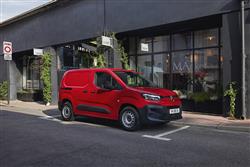Citroen Berlingo Van - ABC Leasing
How will you view?
This is a sample, showing 30 seconds of each section.
LEARNING THE BER-LINGO(some text hidden)
By Jonathan Crouch
Ten Second Review word count: 68
The much improved version of Citroen's third generation Berlingo remains one of the market's best selling compact vans, offering a usefully large payload capacity and a maximum load volume of up to 4.4m3. It's now smarter looking than before and gets some extra tech, plus there's a longer-ranging EV version. The idea is to rejuvenate this model's buying proposition and on paper at least, the prospects are promising.
Background word count: 302
Think of a compact but spacious van and it's really quite likely that you'll find yourself considering this one, Citroen's Berlingo. It is, after all, the model most people think of when considering this category. Here's an improved and more sophisticated version of the third generation model. It shares its engineering and EMP2 chassis with three other Stellantis Group models (the Peugeot Partner, the Vauxhall Combo and the Fiat Doblo), as well as one Toyota (the Proace City). It's Citroen though, that has the most heritage in this sector. This was the first brand to introduce a diesel powered LCV, the first to launch a van with an integrated load area and the first to launch an LCV model with three seats in the cabin. Compact vans of this kind from this French brand go all the way back to the C4 Fourgon model of 1928, which was succeeded in 1951 by arguably the most iconic small LCV of all time, the 2CV van, the world's first mass produced front wheel drive commercial vehicle. Nearly one and a quarter million examples of it were sold over 27 years of production and though successive models, the Arcadiane of 1978 and the C15 of 1984, sold quite well, they never attracted quite the same kind of following. The Berlingo model line though has, with well over 1.5 million sales to date, though it's hard to imagine examples of it ever becoming collector's items in the way the 2CV van now is. The Berlingo nameplate first arrived in the LCV segment in 1996, with a second generation version launched in 2008, then updated in 2015. Building on this strong heritage, this MK3 Berlingo Van - launched in late 2018 - marked a thorough renewal of this best-seller, built upon with this update in early 2024.
Driving Experience word count: 251
The MK3 Berlingo van sits on the Stellantis Group's sophisticated, light 'EMP2' platform and uses an efficient pair of diesel engines. Most opt for the usual BlueHDi 100 diesel variant, this base engine providing 102hp and featuring a 6-speed manual gearbox. There's also a 1.5-litre BlueHDi 130 powerplant; this top 130hp diesel unit comes only with EAT8 auto transmission. The key change made to the engineering of this updated model lies with changes made to the E-Berlingo EV version, which gains a new 52kWh battery providing for an increased range between charges of 205 miles. As before, the battery pack energises a 136hp front-mounted motor with 270Nm of torque. And there's a regenerative braking system that can now be activated at three different levels using steering wheel paddles. Citroen reckons that this is the most comfort-orientated compact van you can buy, thanks to its 'Advanced Comfort programme' development. This is based around special cushioned seats, top-level acoustic treatment and special suspension settings designed to filter out bumps you'd really feel on rival models. Another clever touch is the 'Magic Wash' function that maintains visibility during window washing and halves the amount of liquid required. As before, a Grip Control option is available on some models to increase traction, incorporating hill-start assist. We like the 'Flankguard' feature which informs the driver of the proximity of objects to the side of the manoeuvring vehicle by memorising the data recorded by sensors located in the front and rear bumpers, combined with the vehicle trajectory.
Pictures (High res disabled)

.jpg)
.jpg)
.jpg)
.jpg)
.jpg)

Scoring
Category: Compact Car
| Performance | |
| Handling | |
| Comfort | |
| Space | |
| Styling | |
| Build | |
| Value | |
| Equipment | |
| Economy | 80% |
| Depreciation | 70% |
| Insurance | 60% |
| Total | 75% |